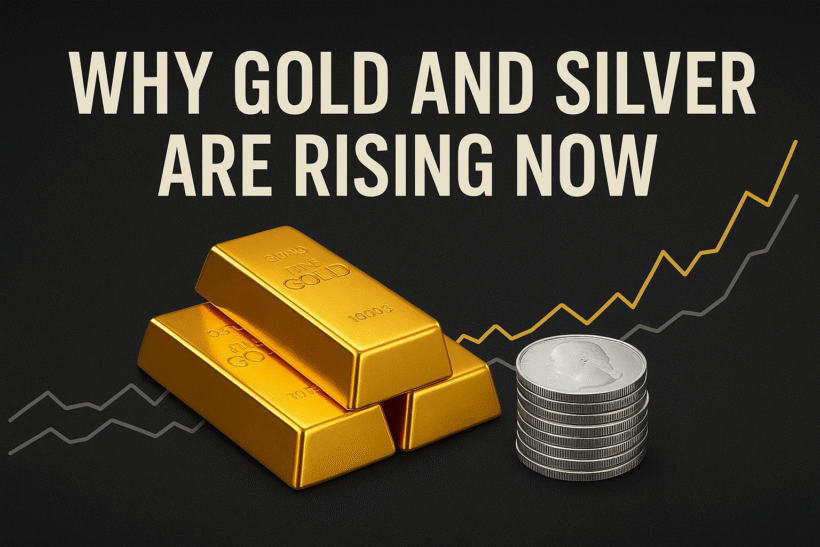Why Gold and Silver Are Rising Now — and What Global Investors Are Saying
Updated October 2025 • By Ankit Joshi (ajexplains.com)
Quick snapshot (what happened)
• Gold’s spot price crossed the $4,000/oz threshold and extended toward $4,200/oz in mid-October 2025, recording fresh all-time highs.
• Silver climbed strongly in 2025 as industrial demand and investor flows converged, tightening available inventories and drawing analyst attention.
1) Monetary policy expectations: “lower for longer” rates help metals
A primary driver for precious metals is the path for real interest rates (nominal rates minus inflation). When real yields decline, the opportunity cost of holding non-yielding assets such as gold and silver falls. In 2025 markets priced in a greater chance of interest-rate cuts by major central banks, notably the U.S. Federal Reserve. That pushed expected real yields lower and raised the appeal of bullion as a store of value and portfolio insurance.
Lower expected rates reduce the carry penalty for bullion and make gold and silver comparatively more attractive. This linkage between falling real yields and rising metal prices has been a common thread in market reporting and analyst notes through 2025.
2) Central bank buying and reserve diversification
For several years central banks — particularly in Asia, the Middle East and parts of emerging markets — have been steadily increasing gold reserves to diversify away from heavy dollar exposure. World Gold Council data and central-bank reports show continued sovereign purchases and elevated official demand. Large, strategic purchases by central banks differ from speculative flows: these are long-term positions that absorb supply and create a firm base under prices.
Two key effects arise from official buying: it removes above-ground metal from available market inventories, and it signals to private investors that gold is increasingly viewed as a reserve asset. That signaling can change investor psychology and strengthen sustained demand.
3) ETF inflows and private investor FOMO
Exchange-traded funds backed by physical gold and silver are a major marginal buyer. As prices accelerate, large inflows into gold ETFs — representing both institutional and retail appetite — were recorded. ETF managers buy physical metal to match new share creation, which directly lifts physical demand.
Alongside structural buying, rapid price gains spawn FOMO (fear of missing out). Momentum buyers and speculators can amplify rallies that already have institutional support, creating short-term price acceleration.
4) The dollar: weakness makes bullion cheaper globally
Precious metals trade in U.S. dollars. A softer dollar typically supports higher dollar-priced commodity values because purchases by non-dollar buyers become cheaper in local terms. In 2025, commentary pointed to a gradual shift in the dollar’s dominance in parts of global foreign-reserve allocation. That shift, and periodic dollar weakness, helped support metal prices by increasing global demand elasticity.
5) Geopolitical risk and macro uncertainty
Geopolitical tensions, sanctions, and the risk of trade fragmentation raise demand for universally recognized, hard-to-freeze assets. Gold’s role as a geopolitical hedge re-emerged in investor narratives: states, institutions and private individuals buy bullion to reduce exposure to sanctions, cross-border banking frictions and currency disruptions. Press coverage in 2025 linked several rallies to specific geopolitical events that shifted investor sentiment toward safe-haven holdings.
6) Silver’s dual role: precious metal and industrial metal
Silver has a hybrid identity: it is both a monetary (precious) metal and an industrial commodity. That means it reacts to investor flows like gold but also follows industrial demand cycles. An important theme in 2025 is the rising role of silver in decarbonization technologies — solar photovoltaics, electric vehicles and electronics rely on silver for conductivity and reflectivity.
Industry studies and the World Silver Survey documented rising structural industrial demand alongside tight inventories. This creates the risk of a sharper price move (sometimes called a “silver squeeze”) because available above-ground silver inventories are relatively small compared with potential demand shocks.
Manufacturers are responding by lowering silver per solar cell to contain costs; that adaptation itself signals structural price pressure.
7) Supply constraints and mining realities
Mining supply adjusts slowly. New mine projects require long lead times, major capital, and often complex permitting and environmental reviews. In 2025 some mining projects faced technical and regulatory hurdles that restrained incremental supply growth. For silver, particularly, low exchange inventories made the market more sensitive to extra demand. Gold’s mining supply is larger but still relatively inelastic in the short run — that amplifies price moves when demand rises.
8) What major banks and large investors are saying
Several large financial institutions and asset managers publicly highlighted structural reasons to allocate to precious metals in 2025:
- HSBC: Revised higher multi-year gold forecasts and noted that continued central-bank buying and geopolitical risks could push gold materially higher.
- J.P. Morgan and other research desks: Flagged central-bank purchasing and the strategic case for gold as a reserve asset, while warning of potential volatility driven by speculative positioning.
- Precious-metals funds (e.g., Sprott): Emphasized the industrial demand case for silver and the risk that constrained inventories could produce outsized price moves.
Market reporting generally frames the rally as a mix of tactical (rate expectations) and structural (reserve diversification and industrial demand) drivers. Analysts differ on sustainability — some warn bubble risk while others emphasize long-term fundamentals.
9) Investor positioning: who’s buying and why
Different investor groups are participating for different reasons:
- Central banks: Strategic reserve buyers seeking diversification.
- ETFs & institutions: Tactical and strategic exposure, with ETFs providing transparent flow data.
- Retail and momentum traders: Short-term buyers amplifying price moves.
- Industrial consumers (silver): Real economy demand from solar, electronics and EV supply chains.
Central banks tend to hold for the long term; ETFs and institutions have medium horizons; retail and speculators often trade short-term. This mix supplies both underlying demand and the potential for volatility.
10) Risks and counterarguments (what could stop the rally)
Key risks include:
- Stronger-than-expected real yields: If inflation moderates and central banks keep rates higher, the opportunity cost of holding bullion rises.
- Dollar strength: A resurgent dollar would reduce demand from non-USD holders.
- Speculative blow-off: Rapid inflows can create technical bubbles and sharp corrections.
- Long-term supply response: Over years, higher prices incentivize mine development and recycling, which can ease shortages.
Investors often use precious metals as a small portfolio insurance position rather than a primary return engine. That approach balances the hedge benefits against volatility.
11) Practical takeaways for different investors
Long-term allocators (pensions, sovereign funds): Treat gold as part of reserves and accumulate gradually to avoid timing risk.
Retail investors: Expect volatility. ETFs provide liquidity; physical bullion requires custody, storage and insurance planning.
Speculators/traders: Use disciplined risk management and be ready for sharp pullbacks.
Industrial consumers (silver): Consider hedging strategies, procurement planning and potential material substitution where feasible.
12) Bottom line
Gold’s record run and silver’s rally in 2025 are driven by a blend of short-term macro factors and deeper structural themes: rate expectations and ETF flows on the one hand, and central bank reserve diversification plus decarbonization-driven industrial demand for silver on the other. While some market commentators warn of speculative excess, many large institutions publicly recognize the structural case for continued precious-metal allocation — albeit sized as portfolio insurance rather than a dominant holding.
Key sources and references
These are the primary reports and articles used to prepare this post. They include market reports, central bank data, and industry studies.
- Reuters — “Gold extends record run past $4,200 on rate-cut hopes” (Oct 15, 2025). Source: Reuters.
- World Gold Council — Gold ETF holdings, flows and central bank statistics (October 2025). Source: World Gold Council / Goldhub.
- HSBC research / Reuters reporting — HSBC forecast on gold (October 2025). Source: HSBC / Reuters.
- The Silver Institute — World Silver Survey 2025 (April 2025). Source: The Silver Institute.
- Sprott — Silver investment research and mid-2025 outlook (July 2025). Source: Sprott Asset Management.
- Bloomberg / Reuters market commentary on ETF inflows and central-bank purchases (2025 reporting). Source: Bloomberg, Reuters.







